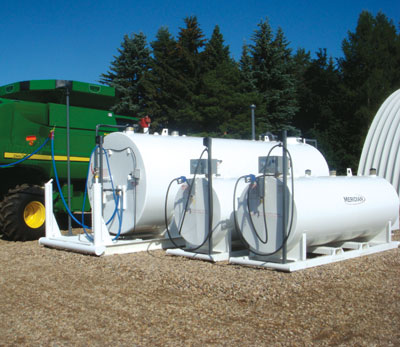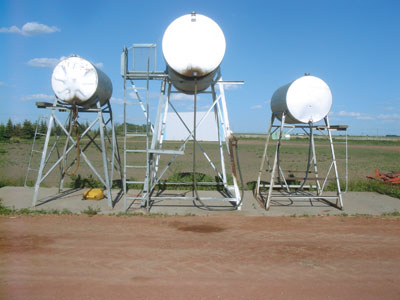
News
New fuel storage strategies
Quietly, that vintage set of farm fuel tanks on spindly metal stands is disappearing on Prairie farms. The replacements, like gigantic white mushrooms, are popping up in modern farmyards equipped with bigger machinery.
April 30, 2010 By John Dietz
Quietly, that vintage set of farm fuel tanks on spindly metal stands is
disappearing on Prairie farms. The replacements, like gigantic white
mushrooms, are popping up in modern farmyards equipped with bigger
machinery.
 |
| A central Alberta farm with new-style double wall fuel tanks. The larger tank holds 25,000 litres of diesel for summer. The smaller tanks hold 4328 litres of winter diesel and gasoline. (Photos courtesy of Meridian) |
The typical replacement these days is a white, shiny, double-wall steel
fuel tank. The skidded tank can be cradled on a bed of crushed rock and
equipped with a high-capacity pump. In Manitoba, it probably will be
well protected with concrete barriers. Size may be as small as 300
gallons, but most likely it will hold several thousand litres of diesel
or gasoline. The cost is much more than a minor expense up front.
However, it also may “pay for itself” rather quickly.
Manitoba-based Meridian Manufacturing Group and Westeel Storage
Solutions dominate the market in producing steel double-wall tanks for
farms. The Huge L Steel Company in Regina is a third supplier.
 |
|
| An old-style single- wall gravity flow tank. |
At this point, thousands of Prairie farms still have old gravity-flow
tanks on stands. “Some have been out there 30 or 40 years, and they’re
starting to show fatigue,” says Ken Pierson, Meridian business
development manager, who is based in Lethbridge, Alberta. “We see a
growing market on farms and in commercial applications for above ground
double-wall storage tanks.”
Both companies now offer a wide choice of double-wall tanks, to sizes
exceeding 60,000 litres. Today’s most popular Meridian tank for farms,
Pierson says, has been the 1000-G double-wall tank. At 4328 litres, it
falls below an important 5000-L threshold. “In Manitoba, because that
tank is less than 5000-L capacity, a guy doesn’t need to have a permit
to have the tank on his farm,” he says. “If the tank is larger than
5000 L, you have to have it installed by a licensed tank installer.”
At the 5000 L size, two permits are required from Manitoba
Conservation. One is for installing it. The other is for operating it,
allowing suppliers to deliver fuel to that tank. A slightly smaller
tank does not require the permits. It even could even be
farmer-installed, although environmental protection rules still need to
be followed.
A fully equipped 4328 L/1000-G double wall skidded tank retails for
under $7500. The 10,000 L skidded double-wall tank fully equipped with
a 20-GPM pump package retails for around $15,000. The 25,000 L version,
complete with a three-inch bottom fill system, overflow alarm and
40-GPM submersible pump would be around $39,000,” Pierson says.
The pump package for large tanks includes a highly reliable
industrial-grade pump that is common at service stations. The meter is
mechanical, with minimum servicing required. The 25-foot hose is rated
for Arctic conditions and has an automatic shut-off nozzle. A damaged
hose or nozzle can be replaced in a few minutes. A CardLock option is
available, as well.
Manitoba is the first province, he says, to require vehicular
protection for on-farm above-ground fuel tanks with a capacity of 5000
L or more. Regulations allow ‘New Jersey-type” concrete barriers, steel
posts, or a combination of both. “It does incur extra cost, but you
want that tank protected,” he adds.
Advantages
Once the new system is working, it definitely has advantages that
offset the cost over time. It will take only 10 minutes to fill a big
thirsty tank on a combine or tractor, and the pump will shut off
automatically. The double wall stops nearly all evaporation losses. The
double-wall tank fully contains the primary tank; a leak from the
primary tank will be contained by the outer tank. The double wall
eliminates any need for a containment dike, which may be a serious
nuisance.
Well-managed large tanks, sized to the needs of the farm, can ensure a
sufficient fuel supply through seasons when shortages occur. Fuel will
be purchased at a lower cost. If the cost of the entire installation is
around $1.50 to $1.75 per litre of storage, it will not take many years
to recover the full cost of the new asset. “You can take early delivery
of a summer fuel supply and save 10 to 20 cents a litre,” he says.
Options closing
Manitoba is the most closely regulated of the three Prairie provinces.
Similar regulation is expected in Saskatchewan and Alberta, but the
dates are less certain, Pierson says.
In Manitoba, options are gradually closing when it comes to using
single-wall gravity flow fuel storage on farms, says Mike Gilbertson,
director, environmental services, Manitoba Conservation. “The code is
moving toward double-wall tanks, or at the very least, secondary
containment. If there’s a leak, the leak will be contained,” he says.
His office is responsible for administering regulations for petroleum
storage anywhere in the province. Manitoba’s most common form of
environmental contamination is from petroleum hydrocarbons (like
gasoline and diesel), he says. “That’s why the regulation was amended
in 2001, and why we’re using the Upgrade Schedule through the Canadian
Council of Ministers of the Environment (CCME), and even looking at
potential amendments to the regulation itself to fully incorporate the
latest CCME requirements.”
The CCME, he explains, published new national codes of practice in
2003. Manitoba, in 2004, introduced an upgrade schedule for storage
facilities. It is enforced through operating permits. If a farm has
5000 L of fuel storage capacity in a single unit, the entire fuel
storage system must conform to the regulation. Some regulations apply
to smaller storage capacity, as well.
The 2006 upgrade required all new tanks in Manitoba, with 5000-L
storage capacity, to meet the ULC standards. The 2008 upgrade set
standards for underground piping and improved leak detection. The 2010
upgrade will set new standards for spill containment, runoff
collection, connections, caps, adaptors, containment sumps and overfill
protection.
|